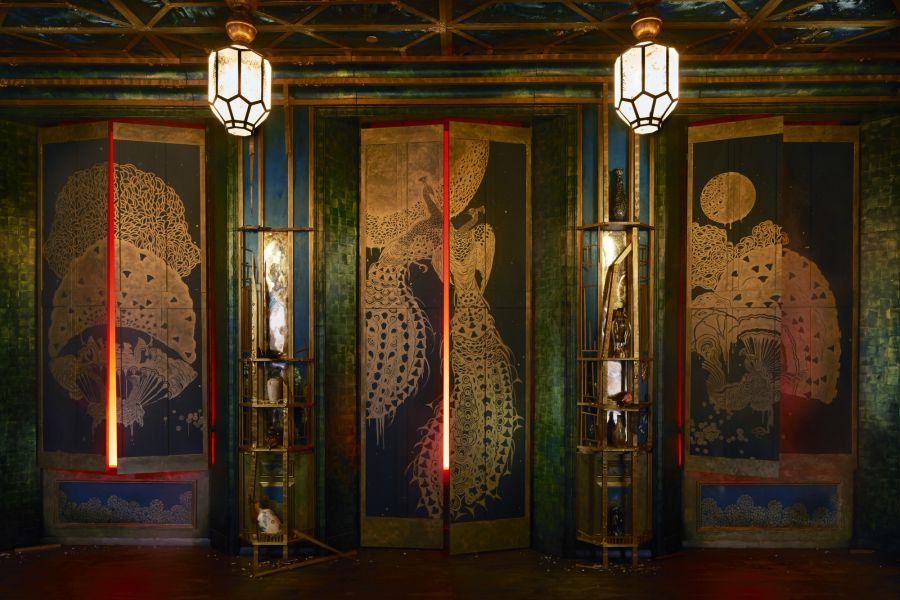Contemporary Arts Museum Looks BackBy Stephen Dravis, iberkshires Staff
12:33AM / Wednesday, June 11, 2014 | |
 |
|

Rosa Barba's 'The Long Road, 2010,' above, is 35mm color film installation going on display at Mass MoCA, channeling its inner Clark Art Institute as part of its 'The Dying of the Light' exhibit. Left: Darren Waterston's 'Filthy Lucre, 2013-2014,' courtesy of the artist and DC Moore Gallery, will be part of Mass MoCA's 'Uncertain Beauty' exhibit.
|
WILLIAMSTOWN, Mass. -- The Clark Art Institute and Mass MoCA are only about six miles away from one another -- a short drive or a long, but not unreasonable, walk.
But for 15 years since North Adams' Massachusetts Museum of Contemporary Art opened its doors, it has seemed much further apart from the more established bastion of 19th and early 20th century art.
But times, they are a'changing.
The Clark, which made its first foray into the contemporary art scene a few years ago with the Stone Hill Center, dives full-bore into the late 20th century art scene in August when "Make It New: Abstract Paintings from the National Gallery of Art" debuts at the museum's sleek, ultramodern visitors and exhibition center.
Meanwhile, in the Steeple City, MoCA has gone retro with a couple of shows that harken back to a masterpiece painted in 1877 and an art form that is all but extinct.
"This summer, you'll go to the Clark and see 20th century artwork and contemporary work," Mass MoCA Director Joe Thompson said at a joint press event with the Clark and other area cultural venues this spring.
"You go to Mass MoCA, and you'll see these references to what we think of as the Clark's backyard. I just like that it turns expectations on their head."
Darren Waterston's show "Uncertain Beauty" premiered in March and runs through January. Its centerpiece is "Filthy Lucre," a full-scale "re-imagining" of the James McNeill Whistler's "Peacock Room," which the artist created in London in the 1870s.
Thompson said Waterston was intrigued by the Peacock Room as an emblem of the excess of the Gilded Age.
"And he noted that in a way we're in another gilded age today with the disparity of income in our society," Thompson said. "He was looking for a kind of metaphor.
"He picked this building, and he is literally building a 1-to-1, immaculately detailed reproduction of Whitler's Peacock Room ... with gilding on the walls and hundreds of finely-crafted bookshelves holding Chinese porcelains.
"But in Darren's version, it's as if it's on some sort of terrible, nightmarish, psychadelic trip. Literally, the ceramics are melting, they're broken. The shelves are askew. The gilding is melting from the walls and collecting in puddles on the floor. It's as if some catastrophe is unfolding before your eyes."
OK, so maybe MoCA is putting an ultra-contemporary spin on that 19th century work. But the another MoCA exhibit is considerably more true to the original.
"The Dying of the Light: Film as Medium and Metaphor," is a collection of works by six artists who celebrate the special qualities of film in a world where digital is now king.
"One of them, Tacita Dean, for example, captured an astronomical phenomenon, a green flash that happens on the horizon in certain desert conditions," Thompson said. "When you try to film it with digital film, it literally won't record because it's too soft. She put a very nice film-based camera there, and you can see this Northern Lights-like phenomenon."
Thompson said "Dying of the Light" incorporates elements of science and psychology while looking back at history.
As for the confluence between Mass MoCA and the Clark, that is not as jarring to insiders as it may be to some on the outside looking in. The two institutions have a long and successful history of working together, and while the Clark is expanding its reach to include modern art, MoCA is not likely to put on any French Impressionist shows any time soon.
That said, it is not unusual for contemporary artists to find their inspiration in the past, Thompson said.
"A lot of artists [like Waterston] are looking back to historical works," he said. "Particularly these artists in the film show. It's their homage, in a way, to filmmaking. They're sad that Kodak is going away.
"It's interesting that it's fine artists now rather than filmmakers -- contemporary filmmakers have largely moved on to digital modes -- but maybe it's not surprising that artists are noticing the fine grain of film, that special luminosity you get when you're passing light through celluloid.
"There's just a nuance, a visual nuance you get in film that can't quite be captured in digital."
| 
 MEMBER SIGN IN
MEMBER SIGN IN
 MEMBER SIGN IN
MEMBER SIGN IN